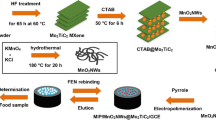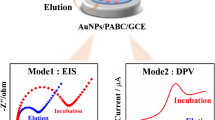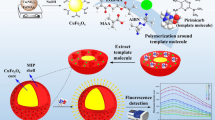Abstract
Carbendazim (CBD) is widely used as a fungicide that acts as a pesticide in farming to prevent crop diseases. However, CBD can remain on crops for a long time. When consumed by humans and animals, it produces a range of toxic symptoms and poses a serious threat to their health. Therefore, the detection of CBD is necessary. Traditional assay strategies for CBD detection, although sensitive and practical, can hardly achieve fast, robust monitoring during food processing and daily life. Here, we designed a novel electrochemical sensor for CBD detection. In this method, iron oxyhydroxide nanomaterial (β-FeOOH) was first prepared by hydrothermal method. Then, a molecularly imprinted polymer (MIP) layer was electropolymerized on the surface using CBD as the template and resorcinol (RC) as the functional monomer. The synergistic interaction between β-FeOOH and MIP endows the MIP/β-FeOOH/CC-based electrochemical sensor with high specificity and sensitivity. Under optimal conditions, the MIP/β-FeOOH/CC-based sensor showed a wide linear range of 39 pM–80 nM for CBD and a detection limit as low as 25 pM. Therefore, the as-prepared sensor can be a practical and effective tool for pesticide residue detection.
Graphical abstract







Similar content being viewed by others
Availability of data and materials
Data and materials available on request from the authors.
References
Eissa S, Zourob M (2017) Selection and characterization of DNA aptamers for electrochemical biosensing of carbendazim. Anal Chem 89:3138–3145. https://doi.org/10.1021/acs.analchem.6b04914
Farag A, Ebrahim H, ElMazoudy R et al (2011) Developmental toxicity of fungicide carbendazim in female mice. Birth Defects Res 92:122–130. https://doi.org/10.1002/bdrb.20290
Singh S, Singh N, Kumar V et al (2016) Toxicity, monitoring and biodegradation of the fungicide carbendazim. Environ Chem Lett 14:317–329. https://doi.org/10.1007/s10311-016-0566-2
Chen X, Lin M, Sun L et al (2019) Detection and quantification of carbendazim in Oolong tea by surface-enhanced Raman spectroscopy and gold nanoparticle substrates. Food Chem 293:271–277. https://doi.org/10.1016/j.foodchem.2019.04.085
Chen M, Zhao Z, Lan X et al (2015) Determination of carbendazim and metiram pesticides residues in reapeseed and peanut oils by fluorescence spectrophotometry. Measurement 73:313–317. https://doi.org/10.1016/j.measurement.2015.05.006
Wang S-Y, Shi X-C, Liu F-Q et al (2020) Chromatographic methods for detection and quantification of carbendazim in food. J Agr Food Chem 68:11880–11894. https://doi.org/10.1021/acs.jafc.0c04225
Malarkodi C, Rajeshkumar S, Annadurai G (2017) Detection of environmentally hazardous pesticide in fruit and vegetable samples using gold nanoparticles. Food Control 80:11–18. https://doi.org/10.1016/j.foodcont.2017.04.023
Guo Y, Zhang L, You H et al (2022) A solution-based SERS sensing protocol via the ultra-rapid and highly efficient molecule enrichment strategy. Sens Actuators B Chem 367:132064. https://doi.org/10.1016/j.snb.2022.132064
Yang X, Liu H, Ji Y et al (2022) A molecularly imprinted biosensor based on water-compatible and electroactive polymeric nanoparticles for lysozyme detection. Talanta 236:122981. https://doi.org/10.1016/j.talanta.2021.122891
Alizadeh N, Salimi A (2018) Ultrasensitive bioaffinity electrochemical sensors: advances and new perspectives. Electroanalysis 30:2803–2840. https://doi.org/10.1002/elan.201800598
Zhou S, Liu C, Lin J et al (2022) Towards development of molecularly imprinted electrochemical sensors for food and drug safety: progress and trends. Biosensors 12:369. https://doi.org/10.3390/bios12060369
Li Y, Chen X, Ren H et al (2022) A novel electrochemical sensor based on molecularly imprinted polymer-modified C-ZIF67@Ni for highly sensitive and selective determination of carbendazim. Talanta 237:122909. https://doi.org/10.1016/j.talanta.2021.122909
Cheema JA, Aydemir N, Carraher C et al (2021) Insect odorant receptor nanodiscs for sensitive and specific electrochemical detection of odorant compounds. Sens Actuators B Chem 329:129243. https://doi.org/10.1016/j.snb.2020.129243
Cao W, Wang Y, Zhuang Q et al (2019) Developing an electrochemical sensor for the detection of tert-butylhydroquinone. Sens Actuators B Chem 293:321–328. https://doi.org/10.1016/j.snb.2019.05.012
Simioni NB, Silva TA, Oliveira GG et al (2017) A nanodiamond-based electrochemical sensor for the determination of pyrazinamide antibiotic. Sens Actuators B Chem 250:315–323. https://doi.org/10.1016/j.snb.2017.04.175
Chen L, Wang T, Xue Y et al (2018) Rationally armoring PtCu alloy with metal-organic frameworks as highly selective nonenzyme electrochemical sensor. Adv Mater Interfaces 5:1801168. https://doi.org/10.1002/admi.201801168
Rehman NC, Ozdemir N, Boyacioglu H et al (2024) A novel molecularly imprinted electrochemical sensor based on graphitic carbon nitride nanosheets decorated bovine serum albumin@MnO2 nanocomposite for zearalenone detection. J Food Compost Anal 125:105857. https://doi.org/10.1016/j.jfca.2023.105857
Chen L, Xu S, Li J (2011) Recent advances in molecular imprinting technology: current status, challenges and highlighted applications. Chem Soc Rev 40:2922–2942. https://doi.org/10.1039/c0cs00084a
Akici SY, Bankoglu Yola B, Karslıoglu B et al (2023) Fenpicoxamid-imprinted surface plasmon resonance (SPR) sensor based on sulfur-doped graphitic carbon nitride and its application to rice samples. Micromachines 15:6. https://doi.org/10.3390/mi15010006
Capar N, Polat I, Yola BB et al (2023) A novel molecular imprinted QCM sensor based on MoS2NPs-MWCNT nanocomposite for zearalenone determination. Microchim Acta 190:262. https://doi.org/10.1007/s00604-023-05842-8
Capar N, Yola BB, Polat I et al (2023) A zearalenone detection based on molecularly imprinted surface plasmon resonance sensor including sulfur-doped g-C3N4/Bi2S3 nanocomposite. Microchem J 193:109141. https://doi.org/10.1016/j.microc.2023.109141
Huang Y, Sun X, Yang J et al (2023) A molecularly imprinted electrochemical sensor with dual functional monomers for selective determination of gatifloxacin. Microchim Acta 190:261. https://doi.org/10.1007/s00604-023-05839-3
Zhong C, Yang B, Jiang X et al (2018) Current progress of nanomaterials in molecularly imprinted electrochemical sensing. Crit Rev Anal Chem 48:15–32. https://doi.org/10.1080/10408347.2017.1360762
Zhang Y, Yan P, Wan Q et al (2016) Morphology-dependent electrochemistry of FeOOH nanostructures. Electrochem Commun 68:10–14. https://doi.org/10.1016/j.elecom.2016.04.007
Zhang D, Han X, Kong X et al (2020) The principle of introducing halogen ions into β-FeOOH: controlling electronic structure and electrochemical performance. Nano-Micro Lett 12:107. https://doi.org/10.1007/s40820-020-00440-2
Chen X, Wang Q, Cheng Y et al (2022) S-doping triggers redox reactivities of both iron and lattice oxygen in FeOOH for low-cost and high-performance water oxidation. Adv Funct Mater 32:2112674. https://doi.org/10.1002/adfm.202112674
Ma P, Luo S, Luo Y et al (2020) Vertically aligned FeOOH nanosheet arrays on alkali-treated nickel foam as highly efficient electrocatalyst for oxygen evolution reaction. J Colloid Interface Sci 574:241–250. https://doi.org/10.1016/j.jcis.2020.04.058
Knezevic S, Ognjanovic M, Gavrovic Jankulovic M et al (2021) S-adenosyl-L-homocysteine hydrolase immobilized on citric acid-capped gallium oxyhydroxide on SWCNTs modified electrode for adohcy impedimetric sensing. Electroanalysis 34:15–24. https://doi.org/10.1002/elan.202100362
Yang D, Lei L, Yang K et al (2022) An immunochromatography strip with peroxidase-mimicking ferric oxyhydroxide nanorods-mediated signal amplification and readout. Microchim Acta 189:58. https://doi.org/10.1007/s00604-021-05085-5
Xia H, Zhang Z, Liu J et al (2019) Developing superior catalysts engineered by multichannel healing strategy for advanced oxidation. Appl Catal B 250:189–199. https://doi.org/10.1016/j.apcatb.2019.03.033
Jin S, Ma X, Pan J et al (2021) Oxygen vacancies activating surface reactivity to favor charge separation and transfer in nanoporous BiVO4 photoanodes. Appl Catal B 281:119477. https://doi.org/10.1016/j.apcatb.2020.119477
Zheng Y, Zhang Z, Li C (2016) Beta-FeOOH-supported graphitic carbon nitride as an efficient visible light photocatalyst. J Mol Catal A Chem 423:463–471. https://doi.org/10.1016/j.molcata.2016.07.032
Srinivas S, Ashokkumar K, Sriraghavan K et al (2021) A prototype device of microliter volume voltammetric pH sensor based on carbazole-quinone redox-probe tethered MWCNT modified three-in-one screen-printed electrode. Sci Rep 11:13905. https://doi.org/10.1038/s41598-021-93368-5
Cheng J, Li Y, Zhong J et al (2020) Molecularly imprinted electrochemical sensor based on biomass carbon decorated with MOF-derived Cr2O3 and silver nanoparticles for selective and sensitive detection of nitrofurazone. Chem Eng J 398:125664. https://doi.org/10.1016/j.cej.2020.125664
Ma Y, Li J, Wang L (2021) Porous carbon derived from ZIF-8 modified molecularly imprinted electrochemical sensor for the detection of tert-butyl hydroquinone (TBHQ) in edible oil. Food Chem 365:130462. https://doi.org/10.1016/j.foodchem.2021.130462
Li D, Wu C, Tang X et al (2021) Electrochemical sensors applied for in vitro diagnosis. Chem Res Chin Univ 37:803–822. https://doi.org/10.1007/s40242-021-0387-0
Ghorbani A, Ojani R, Ganjali MR et al (2021) Direct voltammetric determination of carbendazim by utilizing a nanosized imprinted polymer/MWCNTs-modified electrode. J Iran Chem Soc 18:3109–3118. https://doi.org/10.1007/s13738-021-02255-3
Li Y, Feng Y, Chen S et al (2022) Signal on-off ratiometric electrochemical sensor coupled with a molecularly imprinted polymer for the detection of carbendazim. Microchim Acta 189:250. https://doi.org/10.1007/s00604-022-05341-2
Beigmoradi F, Rohani Moghadam M, Bazmandegan-Shamili A et al (2022) Electrochemical sensor based on molecularly imprinted polymer coating on metal-organic frameworks for the selective and sensitive determination of carbendazim. Microchem J 179:107633. https://doi.org/10.1016/j.microc.2022.107633
Kasaeinasab A, Mahabadi HA, Shahtaheri SJ et al (2023) Carbendazim trace analysis in different samples by using nanostructured modified carbon paste electrode as voltametric sensor. PLoS One 18:e0279816. https://doi.org/10.1371/journal.pone.0279816
Elshafey R, Abo-Sobehy GF, Radi A-E (2021) Imprinted polypyrrole recognition film @cobalt oxide/electrochemically reduced graphene oxide nanocomposite for carbendazim sensing. J Appl Electrochem 52:45–53. https://doi.org/10.1007/s10800-021-01613-6
Yola ML (2022) Carbendazim imprinted electrochemical sensor based on CdMoO4/g-C3N4 nanocomposite: application to fruit juice samples. Chemosphere 301:134766. https://doi.org/10.1016/j.chemosphere.2022.134766
Acknowledgements
The authors thank Dr. Chao Wang of the Department of Chemistry and Chemical Engineering (SUST) for helpful advice and discussion.
Funding
This work was financially supported by the General Project of Shaanxi Province Research and Development Key Program (No. 2022NY-042), Xi’an Science and Technology Planning Project–Scientific and Technological Personnel Service Enterprise Project (No. 22GXFW0012), Xi’an Key Laboratory of Advanced Performance Materials and Polymer (No. 2021122), Science and Technology Plan Project by Shaanxi Provincial Education Department (No. 21JP114) and District of Shaanxi Province Project (No. 202129), Science Technology Department of Shaanxi province (No. 2022PT-44), and the Scientific Research Program Funded by the Shaanxi Provincial Education Department (21JP114).
Author information
Authors and Affiliations
Corresponding authors
Ethics declarations
Ethics approval
This research did not involve human or animal samples.
Conflict of interest
The authors declare no competing interests.
Additional information
Publisher's Note
Springer Nature remains neutral with regard to jurisdictional claims in published maps and institutional affiliations.
Supplementary Information
Below is the link to the electronic supplementary material.
Rights and permissions
Springer Nature or its licensor (e.g. a society or other partner) holds exclusive rights to this article under a publishing agreement with the author(s) or other rightsholder(s); author self-archiving of the accepted manuscript version of this article is solely governed by the terms of such publishing agreement and applicable law.
About this article
Cite this article
Yang, D., Li, X., Li, X. et al. Design and synthesis of nano-iron oxyhydroxide-based molecularly imprinted electrochemical sensors for trace-level carbendazim detection in actual samples. Microchim Acta 191, 163 (2024). https://doi.org/10.1007/s00604-024-06236-0
Received:
Accepted:
Published:
DOI: https://doi.org/10.1007/s00604-024-06236-0




